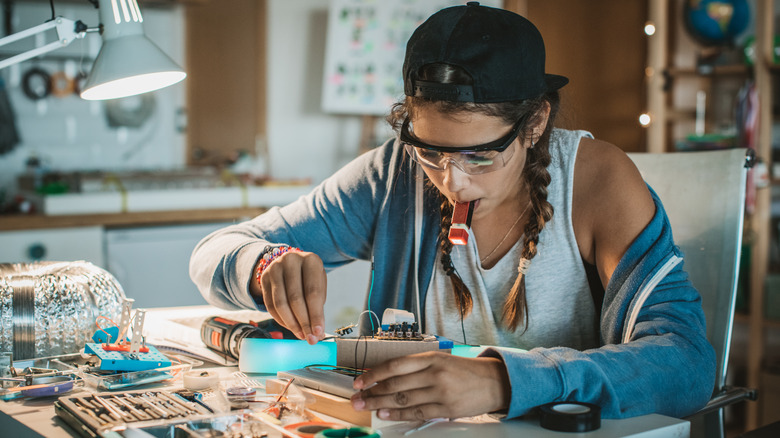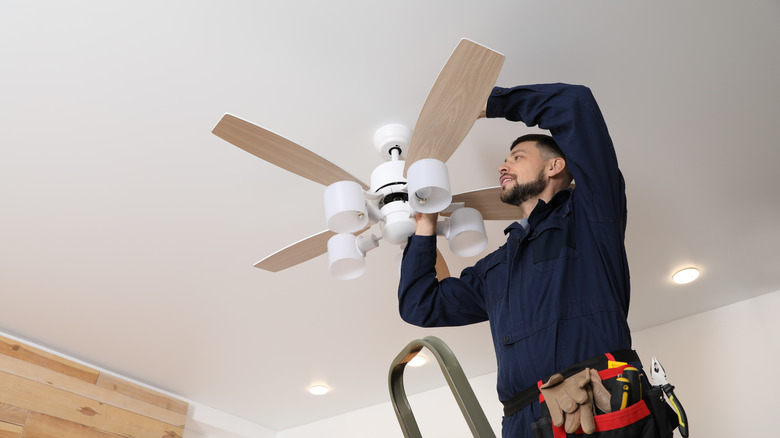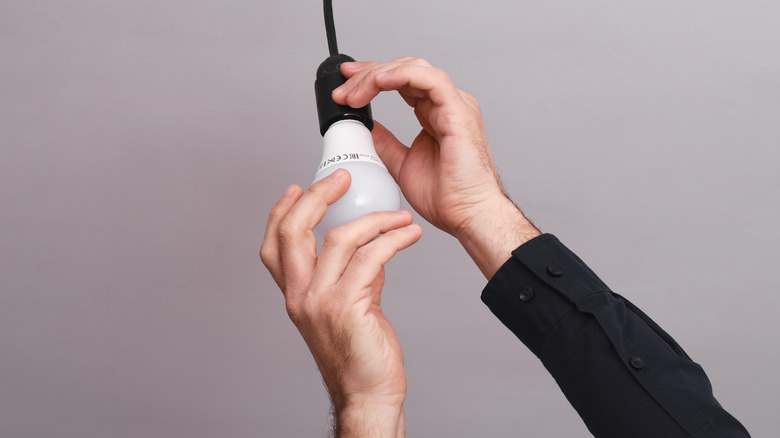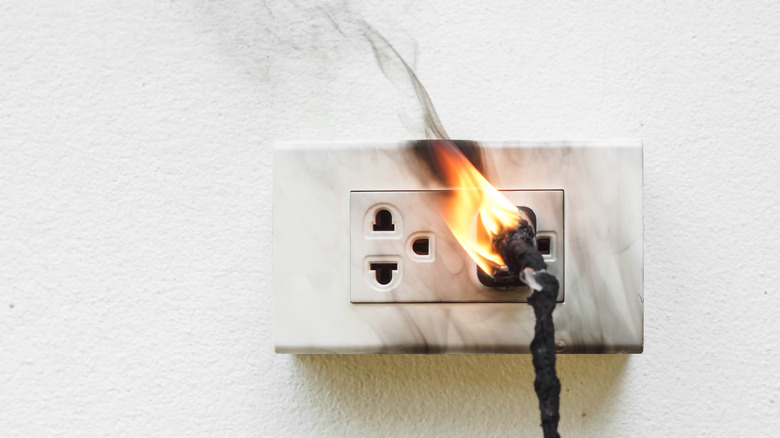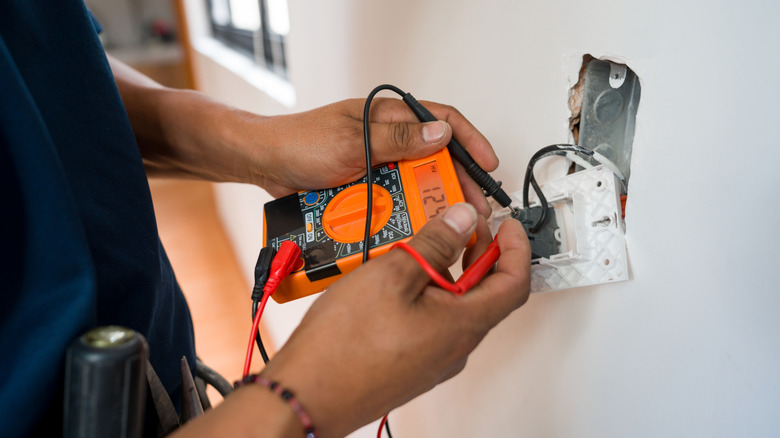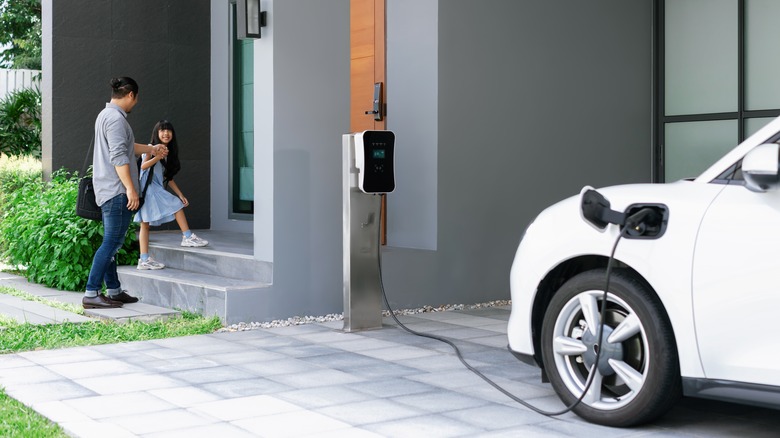Don't Attempt These Electrical Projects At Home Unless You're A Professional
Embarking on a do-it-yourself (DIY) electrical project with no formal education isn't the brightest idea. Fiddling with wires, electrical panels, and other technical components is risky behavior, especially if you haven't been trained by a professional and certified under the United States Department of Labor's Occupational Safety and Health Administration (OSHA). Many of these projects are complex, dangerous, and require extensive knowledge to do correctly and safely, which is why official laws and statutes highly regulate them.
According to the National Fire Protection Association (NFPA), there are almost 47,000 home electrical fires in the United States every year, most of which are caused by electrical failure or malfunction. Households that don't follow proper procedures for the installation and maintenance of their interior wiring and technical devices are the most common culprits of the incidences, as they are home to DIY-savvy individuals who believe they can perform repairs, replacements, and installations single-handedly.
This isn't to say you can't perform simple electrical adjustments around your home. Changing lightbulbs, labeling light switches, and installing security cameras and doorbell cams are usually DIY-friendly unless there are extenuating circumstances. These electrical jobs tend to be within reach, in safe environments, and involve minimal contact with electric currents and wiring. However, many people mistakenly believe that seemingly basic electrical tasks can be completed by any aspiring DIY-er with access to Google.
Motivation to save money, learn something new, or simply avoid the process of finding a qualified electrician are not reasons to engage in potentially dangerous electrical experimentation. There are many electrical repairs, installations, and replacements that unqualified individuals should never undertake, and you can learn more about these projects in the article below.
Installing brand new light fixtures
Over years of home ownership, many individuals change their lighting fixtures for aesthetic or functional reasons. New wall and ceiling lights place the finishing touch on interior designs, uphold current trends, and improve visibility in a room. They don't obstruct floor or table space and are useful for both ambient and task lighting. Due to their popularity, these types of lights are easy to find in various styles online and in local stores, and if you find a good deal, it may be tempting to attempt the installation on your own. However, despite the money you think you'll be saving with a DIY install, you should not go this route when installing any light fixture more complex than a standard plug-in lamp.
Not all states and municipalities have the same requirements but many require classroom training, on-site experience, and official licensing before a person is permitted to perform electrical work. Some states even have different levels of electrical licenses that allow work in strictly residential or commercial environments. Unless you have the designated certification, you cannot lawfully install new lights, and you'll need to check your local statutes to be sure.
Additionally, installing a lighting fixture on your own can void its warranty, as these agreements do not apply to lights that have been improperly installed. Electricians may make mistakes, as all people do, but reputable ones will offer their own warranties. This means that if they do botch setting up your lights, they will cover the cost of repairs and replacements.
There are also additional considerations that come to play when installing lights. Many require mounting brackets and must be placed on surfaces that can support them. Unless you're a trained electrician, you may not know which mounting brackets are the best choice or whether your ceiling or wall is strong enough to hold a lighting system.
Repairing flickering lights
Suppose you don't need to install a brand-new lighting system, but you do need to repair your currently flickering or malfunctioning lights. You should know this is another DIY project best left to the professionals unless you're dealing with a minor problem. Do a quick check on the bulb itself to see if it's within reachable distance. If it's loose, let the surface cool before gently rotating the bulb clockwise. If this makes no difference, you may be using the wrong lightbulb type for the fixture, and you'll need to check your lighting fixture's manual to make sure it's compatible. Keep in mind that fluorescent lights also tend to flicker as they warm up, and this may not be indicative of a problem.
Aside from these quick adjustments, you should not tamper with your fixtures as it's likely that there's a wiring, switch, or connection issue causing the flickering disco lights effect. These problems can be dangerous since loose and outdated wiring leads to arcing electrical currents. Arcs are highly unpredictable as 10,000-degree Fahrenheit electrical currents travel over gaps in connections, potentially causing electrical fires. Knowing this, the safest bet is to power off all flickering lights and contact an electrician as soon as possible.
On a less dangerous note, this situation can also be an electric utility issue, especially if you live in a suburban or urban area connected to many other residences. If someone nearby is using too much power or your shared transformer is malfunctioning, it may be causing outages in your area. In this case, you'll need to call your utility company, not an electrician.
Troubleshooting circuit breakers
Circuit breakers are simplified electrical panels made to minimize homeowner risk while giving them control over all power within their home. These systems turn off power in specific locations when faults are detected. Homeowners can easily flip a switch on or off to restore power or isolate parts of their home, avoiding potentially dangerous situations. Although these systems are basic in terms of user interface, they are not simple in back-end design.
Only certified professionals should perform extensive repair or maintenance work on these devices to ensure they're up to the current electric code and operating correctly. Maintenance requires visual inspections, mechanical testing, and electrical testing beyond a typical person's skillset. These tests include insulation resistance, contact resistance, over-potential (HI POT), timing, and travel tracing analyses to ensure circuit breakers are in prime condition.
No matter how adept you are at internet searching, attempting these tests without proper training and certification won't be covered by your homeowner's insurance if anything does go wrong. This leaves you financially responsible for any damage to your house, electrical devices, and wiring. Not to mention, you can put your family, house, and self in mortal danger due to the risk of electrical fire or shock.
Replacing faulty outlets and switches
When interacting with your outlets or light switches, electrical malfunctions are easy to spot and identify. These points of contact may be hot to the touch and appear singed, implying that there's too much voltage being directed to the area. Cracks and gaps in the plating imply the covers are old and worn, and they must be replaced to keep dust and debris out of your electrical wiring. If you suspect your switch or outlet is overheating because of overuse, try turning them off or unplugging appliances to see if they cool down. Say this turns out to be the case– you'll need to stop plugging so many devices into a single outlet. In any other situation, you should not be the person behind the repairs and replacements.
If pinpointing the problem behind your outlet and switch issues requires a deeper dive into your electrical system, calling a professional contractor is necessary. The cause is often a wiring issue, which as discussed before, should only be approached by trained and certified individuals. Otherwise, you put yourself at risk of burns, shocks, fire damage, and higher repair costs to fix a problem that you exacerbated. Replacing a switch is not as easy as it might seem; many different types require different configurations and have different voltage capacities.
Fixing your own appliances
Manufacturer's manuals contain all the information you'll ever need on your home appliances and one of the most prominent sections is the safety precautions regarding proper installation, maintenance, and use. Throughout any guide, product owners are warned not to tamper with their appliance or its electrical connections for safety reasons and to preserve the condition of the product. Whether the appliance is a small tabletop oven or a large-scale combination washer and dryer, it's strongly discouraged to replace or repair internal parts without the help of a certified professional.
In most cases, this voids the warranty on the appliance, meaning you won't be compensated for any future issues, even if it was recently purchased. On a more serious note, you can put yourself in danger by pinching pennies and skipping on a professional consultation. Household appliances are often connected to gas and water lines in addition to electrical wiring. This makes them highly dangerous to work with as electrical shock and gas and water leak risks are heightened.
DIY appliance repairs also tend to be short-term solutions since they solve the direct problem but not any underlying issues. Many repairs require extensive toolsets, specific replacement parts, and knowledge pertaining to specific appliances. Gas, plumbing, electrical, and refrigeration certifications and licenses exist for a reason – to back the professionals who operate in this field of work, ensuring uneducated homeowners can find reliable and industry-trained contractors.
Installing home surge protectors
Power surges are a common issue in households throughout the United States, and they occur when the voltage in a power line exceeds 170. These surges often result from faulty wiring, electrical overload, or lightning strikes, and they can fry connected devices and cause power outages. Many homeowners install home surge protectors to protect their appliances, lights, and plugged-in devices.
There are small power strips that provide surge protection to all devices plugged into their outlets, and these devices cost between $20 to $300. However, whole-house surge protectors are built to preserve all electrical lines, including appliances, alarms, lights, phones, and internet and cable connections. These protectors stop surges in your home's electric meter and circuit breaker, as well as exterior power lines. Due to the extensive coverage, a professional electrician must install this powerful defensive barrier.
Like most electrical installations, surge protector warranties are only valid when installed by trained electricians. To install them, contractors must work with live electrical panels. Since these panels are active, all the dangers of tampering are heightened, making it imperative you do not attempt to yourself.
To put it simply, the dangers of self-installations far outweigh the cost of hiring a professional to do this job. Incorrect installations can put your entire home and household in danger of electrical fires, not to mention that your DIY surge protector may not even work when there is a spike in the system.
Putting in an electric vehicle charger
Ever since the release of the Tesla Roadster in 2010, electrically-powered vehicles (EVs) have become increasingly popular in the United States. Instead of relying on traditional gas for fuel, these cars are charged with electricity via high-power connectors and charging units. To ensure their vehicles are powered up and ready to drive, many people install EV charging stations in their homes.
These stations use the same amount of voltage as other household appliances, ranging from 120 to 240 volts. They also have different ratings; 12, 16, 20, 24, 32, 40, 48, or 64 amps, which must be adjusted to accommodate the circuit they're connected to. To the common layperson, these numbers are complicated to understand, making it clear as to why you should hire a professional installer for these devices.
Even the first step, choosing the right charger model, requires a professional consultation, as you need to pick one that best fits your car make and model, home electricity supply, and available locations. Many companies, like EV Charging Installers of America LLC, ChargePoint, and COIL, have installers qualified to place their devices, or you can search for a licensed electrician in your area with EV knowledge.
Remember that relying on a professional ensures your device's warranty stays valid, electrical shocks and fires are avoided, and many future issues are financially covered. They must also be installed according to regulations, such as being placed on a dedicated circuit and signed off by a registered electrician. Depending on your location, there may be other rules stipulated by your state or municipality. Since EV chargers are still a relatively new invention, new standards are consistently updated regarding these chargers' technical and electrical standards.
Installing floor or wall heating
Radiant heating, otherwise known as in-floor or in-wall heating, was once a luxury reserved for the wealthiest members of society. However, these installations are becoming more popular in modern homes as radiant heating companies become more profitable yearly. Dave Sniadak, public relations manager for Uponer, a radiant heating company, claims that, "radiant (heating) improves indoor air quality, offers superior energy efficiency, and comfort throughout the home" (via Plumbing & Mechanical). Due to the benefits of this new technology, it's no surprise that homeowners are budgeting for heated walls and floors. Seeing as even small heating devices, such as portable furnaces and hair irons, can pose electrical and fire risks, it's no surprise that DIY floor and wall heating shares these potential issues.
These are objectively complex installations, and many companies specialize explicitly in radiant heating alone. Installing requires extensive knowledge of an individual home and its specifications, and radiant heating contractors have many factors to take into account. Before going forward with installations, they must determine desired heat outputs, wall and flooring substrate types, maximum temperature limits, types of flooring and finishes, and insulation specs.
Professionals must also install a specialized thermostat that is positioned correctly and programmed within safe parameters, and they must place floor and wall sensors throughout the heated rooms. This is not a job for untrained individuals, no matter how mechanically inclined they may be. Electric underfloor heating is complicated in every sense of the word, and a registered electrician must sign off the end product.
Tampering with a Weatherhead in a traditional system
"Weatherhead" is the technical terminology for a feature on traditional residential electrical systems. It's only found on above-ground systems and refers to the rounded cap that directs a utility company's wiring into a house's electrical meter and service entry point. Many areas within the United States still have above-ground cables due to local infrastructure; they are cheaper and easier to maintain despite their safety risk (which is another discussion in and of itself). Since the cables are run on the surface, this cap is required for protection from water, dirt, and pest infestations, which can damage the wiring.
Due to their exposure to outside elements, plastic and metal Weatherheads and their rubber gaskets are prone to cracking and corrosion over time. Replacing a Weatherhead is necessary to ensure your electric supply stays intact, but it can be pricey. Replacement parts are under one hundred dollars, but hiring an electrician costs several hundred since it takes them several hours to complete the job. Mechanically-savvy individuals may believe they're up to completing this task on their own, but this is not a DIY project.
This connection point between a utility company and a residential home transports between 100 and 200 amps— all the electricity needed to power a home (via Elexicon Energy). When doing work on a Weatherhead, electricians coordinate with utility companies to temporarily turn off this power, as the high amounts won't just cause severe injury; they are life-threatening. The power must be shut off to ensure a Weatherhead cap can be switched out safely, and the utility and electric provider must be notified in order to do so. Depending on your local service, they may hire the electrician for you or request that you hire one yourself.
